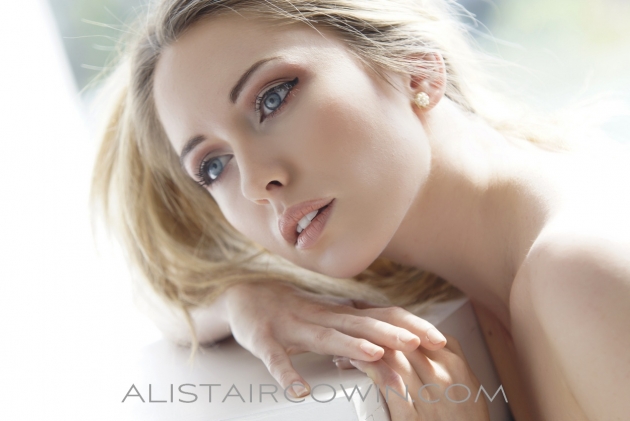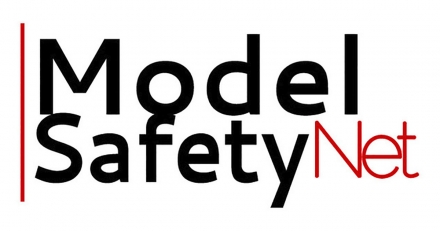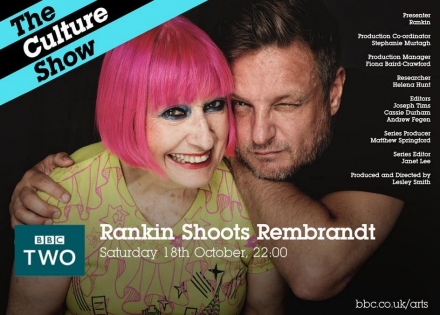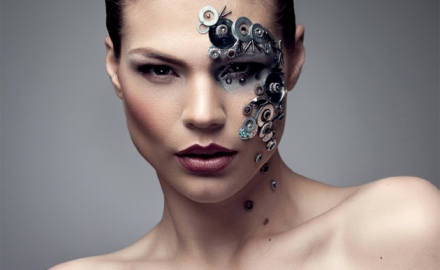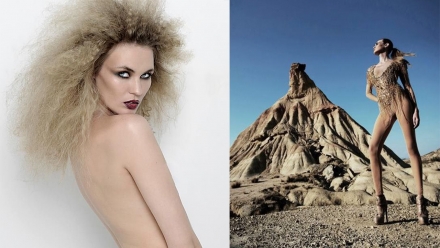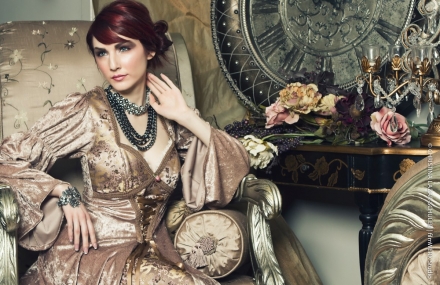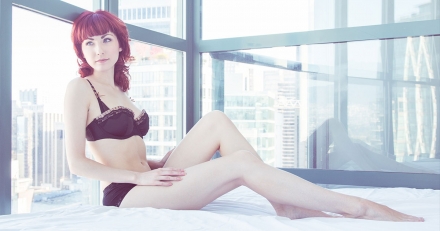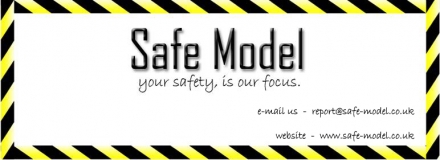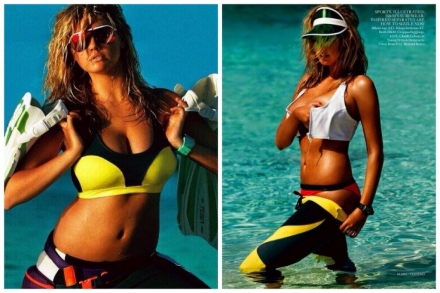Alistair Cowin is one of the most accomplished fashion and beauty photographers in the business, with a string of high profile fashion clients, having lived in LA, Miami, the South of France, and now back in his native UK. He has shot someone of the world’s most photographed women, including Caprice, Charlize Theron, and Cameron Diaz.
Did you have a passion for art while you were growing up?
I was always interested in Art as a subject at school and found out that I was able to draw quite well but nothing much beyond that. I was too interested in avoiding getting caught smoking behind the bike sheds! I went to the Architectural Association in Bedford Square to study architecture for no other reason than both my parents were architects. This took 5 years and involved an additional year in New York pursuing the practical part that my degree course required.

Lydia, photographed by Alistair Cowin
What did you after your architecture degree, that got you into the fashion industry?
I got married whilst at the Architectural Association and had a daughter called Amanda. My mother-in-law just happened to be the Fashion Editor of Queen & Harper’s Magazine at the time and I had an Aunt who was wonderful seamstress. As a ‘hip’ architectural student, fashionably and visually aware, I wanted to dress my daughter in fashionable clothes which were simply not available for small children then. Bazaar in the Kings Road was the hottest shop in town with Mary Quant doing her ‘thing’ and my kid’s clothes designs were in the same mould. Anyway Harper’s featured some of my designs. These were photographed incidentally by a photo assistant working out of a studio across the road called Barry Lategan. He became a good friend of mine as a result. The upshot of this kids fashion feature was that the magazine was literally – and to everyone’s great surprise – inundated by readers enquiring where they could but the clothes. So at the ripe old age of 23 and whilst still continuing with my studies – remember youth was king in the Swinging 60’s in London – I organised a small overdraft from the Bank and opened my first children’s clothing shop called GRADE ONE just off Kensington High Street in London. I was soon supplying my designs to the likes of Miss Selfridge, Top Shop, Harrods etc. and the rest, as they say, is history.

Model: Charlotte Felski
Designer: Molly Mishi May
MUA: Jenny Davies
Hair: Peachy Stylist
Headdress Creations: Liv Free
Stylist: Sue Fyfe-Williams
It took around 4 years’ solid practice, testing and knocking on doors before I got my first real fashion commission
So if being a fashion designer was going well, what prompted the move to photography?
Photography was sort of ‘forced’ on me about twenty years later, in 1982, when my business was destroyed overnight in a huge London fire and I was suddenly out of a job. I had to wait almost 2 years doing virtually nothing before I received any insurance money and it was then that I started ‘messing about’ with photography. Having been in the fashion business for some 20 years or so by this time I had lots of friends and acquaintances ‘in the business’ including Terence Donovan as well as a number of fashion editors and journalists so I thought that becoming a fashion photographer would be easy. Nothing could have been further from the truth as I soon learned that no-one would take me seriously as a photographer unless I earned my stripes – which was exactly what I had to do. So I used the insurance money to buy the lease on a smart studio in Knightsbridge to give myself some outward ‘street cred’ and I offered the use of my ‘new’ studio to the assistant of a photographer friend of mine in return for him ‘teaching ‘ me all about photography. With advice from Terry Donovan and Barry Lategan and practical hands on teaching from Peter Marshall, my personal photoguru, I was able to pick things up pretty quickly. But it still took around 4 years’ solid practice, testing and knocking on doors before I got my first real fashion commission. This was for a 4-day location shoot in Crete to the TV Times ‘knitting section’ and Pete Marshall came out as my assistant. After that first shoot things then started to get busier and my decision to turn from fashion design to fashion photography was vindicated.

Photographed by Alistair Cowin
I realised that the best way to earn a proper living was to try and get ‘multiple day’ shoots
Once you got started, how did your fashion photography career progress? Where did it take you?
I spent a few years working out of my studio in London but realised that the best way to earn a proper living was to try and get ‘multiple day’ shoots. This involved location shooting and finding clients who commissioned lots of location photography. This meant going after the mail order catalogue companies which is exactly what I did.
I was starting to spend quite a few weeks on location abroad, mostly around the Mediterranean, where there was a reasonable chance of good weather, but the constant moving from one location to the other – Spain, Greece, France, Italy, Morocco, Tunisia etc. – took its toll, and so I wanted to find the perfect place where good weather could be guaranteed and I could shoot long-term. During a two-week shoot in California in 1988, where I had 14 days without one ‘bad weather day’ interrupting the shoot, I became convinced that this was where I should be based in the future. So I sold my London studio in January 1992 and moved into Lucille Ball’s wonderful top floor art deco apartment on Wilshire Boulevard in Los Angeles. Shortly after that I moved to Malibu, since a lot of my shoots were beach-based and spent a wonderful 7 years shooting European fashion and Hollywood personalities. My clients ranged in the UK from all the big catalogue names like GUS, Freemans, Grattan to up market store groups such as Harrods, Dickins & Jones, Liberty’s, Fenwicks etc. I also did lots of work for German, Swiss and French fashion retailers. I was booking all the models for these clients myself, including Cameron Diaz, Charlize Theron, and Caprice, as they were based in LA and did some modelling to pay the rent whilst they were trying to launch their film careers. I first shot Cameron Diaz when she was a teenager and my surviving memories of her are that she had a big personality and a great sense of humour; on one unusually rainy afternoon in the motor home reducing me, my two assistants, the stylist, my client and makeup artist to fits of laughter with her unceasing stream of very funny jokes. I first worked with Caprice as a swimsuit model after she had just won the Miss California Teen contest – she was 16! Lots of other big names came my way and it was a memorable time in my life.

Early photos from Cameron Diaz’s modelling career
Sounds like an amazing era – did it continue for long?
In the winter of 1992 there was an earthquake in LA followed by a huge fire along the Malibu coast. In typically exaggerated fashion the European media made it sound like California had fallen into the sea, so my UK and German clients started to get cold feet about shooting there in future. It was obviously time for a change so I decided to move my operation to Miami in Florida, which was just starting ‘to happen’. I ended up building a large studio called CENTER STAGE with a series of very lifelike sets on the lot and then hiring these out to fellow photographers who need something different from the usual beach pictures. It was while I was in Miami that I spent the night with Charlize Theron. Well I say ‘spent the night’ but what actually happened was that she had just become the new ‘Guess Jeans girl’ and was so ‘booked up’ and her availability so limited for this short visit from New York that we shot a fashion feature for Ocean Drive magazine in a large fashion retail store called The Broadway literally overnight, setting up at 9pm when the store closed, and finishing at 6am and before the store opened again in the morning. We got some terrific pictures using both the bedding and lighting departments as background locations! I spent 4 years in Miami and didn’t enjoy it nearly as much as California, primarily because business was hopelessly seasonal, the only reliable weather being from November to March, and I didn’t speak Spanish! I decided to come back to Europe, but this time to the South of France where the weather is still half-way decent. That’s where I first worked with Tess Daly but that’s another story…

Amy, photographed by Alistair Cowin
If I were starting out again I would think seriously about moving images where some exciting technological developments are happening
What advice would you give to photographers who want to make a professional career from it today?
Since film was ‘out’ and digital came ‘in’, the photographic business has changed dramatically – and in some ways much for the better in my view. Principally this is because the opportunities for more people to get involved in taking pictures with digital media has simply exploded. However there are now so many talented photographers out there – especially I’m delighted to say female photographers – which has made the business so much more competitive, that the chances of making a traditionally good living from it have almost disappeared. If I were starting out again I would think seriously about moving images where some exciting technological developments are happening – and all that boring editing that has to be done!

Model: Victoria Lindsay Coutts
Designer: Molly Mishi May
MUA: Marta Red
Hair: Lukas Szejka
Crown Creations: by Liv Free
Stylist: Sue Fyfe-Williams
Sites like Portfora have made my life so much easier particularly as I specialise in beauty work these days
What do you think of modelling agencies?
I have to admit that I have never had a great love for model agencies because, with a very few exceptions, most of them don’t earn their money and they grossly overcharge their models. I also have to admit that I have tried to circumnavigate traditional model agencies throughout my career by booking models direct. The advent of alternative models web sites like Portfora have suddenly made this a reality and it is now possible for almost anyone to try their hand at modelling which is great news for photographers, both professionals and part timers alike.
Sites like Portfora have made my life so much easier particularly as I specialise in beauty work these days – a lot of it for various portfolios and I don’t need towering amazons of 5’10” or more for shooting great beauty pictures. All I need is a lovely face, beautiful eyes and good skin, so my resources for finding and booking good beauty models has expanded dramatically. And so much the better.
To a large extent the same goes for makeup artists, where it has historically been almost impossible for talent outside London to get recognised. I am now using makeup artists from all the place courtesy of the Alternative Model web sites, and the opportunities for finding real talent in this area are enormous now.

Amy, photographed by Alistair Cowin
What makes you choose the models you work with?
I have a number of criteria when choosing and booking a model. First, and probably most important of all, she must be able to communicate. This is where model agencies score because they do ‘all the running’ for both model and photographer when it comes to admin and organisation. If the model can’t do this for herself – and it’s not very difficult, let’s face it – then she shouldn’t be offering her services. The same goes for reliability and this is one area that the ‘alternatives’ need to get their act together. I have been let down on innumerable occasions by girls either not turning up at all, or cancelling at the last moment. On these occasions there is apparently a complete disregard or ignorance of what is involved in organising a photoshoot and usually there are a number of people taking part so they also are inconvenienced. That’s true of my shoots anyway, where I always have a makeup artist, sometimes a hair stylist, and my studio has to be set up and travel arrangements made etc. So ‘no shows’ are a nightmare and shouldn’t be tolerated.
Tell us about your social media habits, and top tips for getting work
As far as social media is involved I am not an expert by any means but I do use Facebook for ‘spreading the word’ whenever I can and I also use Pinterest to put my Beauty images around. At the end of the day the majority of my work comes through reputation and recommendations. From an organisational point of view, the most effective media for me are sites like Portfora, especially now that I’m doing more teaching through my Beauty Photography Master Classes. With these web sites I can reach both models – my lifeblood – and also the photographers – my chief beneficiaries.
It is pretty obvious that Portfora is going to make a big impact… it’s the one for the future!

Georgia, photographed by Alistair Cowin
Any final words you’d like to share?
It is pretty obvious that Portfora is going to make a big impact in the Alternative Model business. It’s easy on the eye, simple to navigate, tremendously useful and, as a result. is growing fast. If you haven’t yet, you surely should be signing up. I shall be using it a lot and can only recommend it thoroughly. It’s the one for the future!
You can view more photos in Alistair’s portfolio on Portfora. We’ll be posting another article about Alistair’s Beauty Photography Master Classes in the near future.







